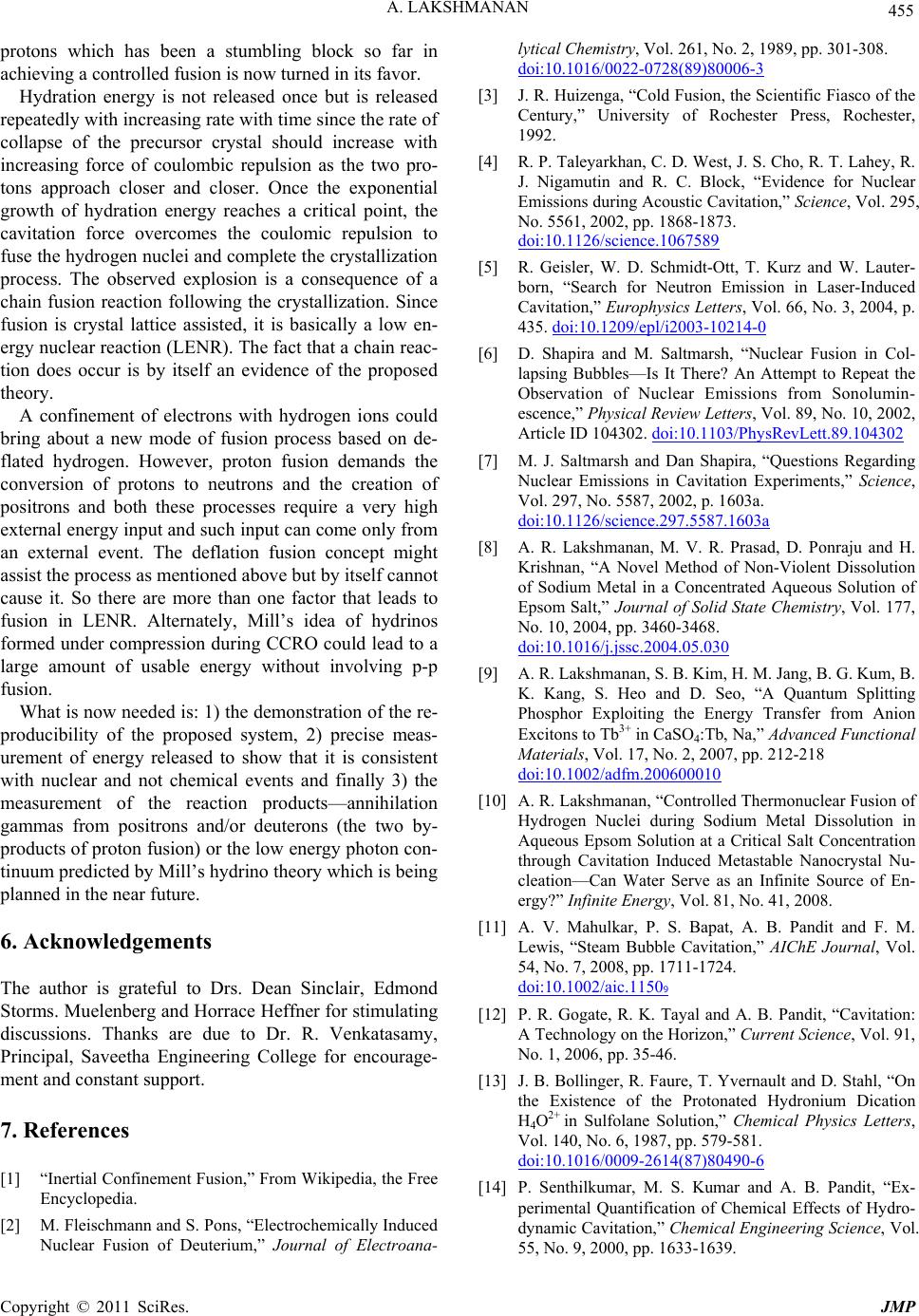
A. LAKSHMANAN
455
protons which has been a stumbling block so far in
achieving a controlled fusion is now turned in its favor.
Hydration energy is not released once but is released
repeatedly with increasing rate with time since the rate of
collapse of the precursor crystal should increase with
increasing force of coulombic repulsion as the two pro-
tons approach closer and closer. Once the exponential
growth of hydration energy reaches a critical point, the
cavitation force overcomes the coulomic repulsion to
fuse the hydrogen nuclei and complete the crystallization
process. The observed explosion is a consequence of a
chain fusion reaction following the crystallization. Since
fusion is crystal lattice assisted, it is basically a low en-
ergy nuclear reaction (LENR). The fact that a chain reac-
tion does occur is by itself an evidence of the proposed
theory.
A confinement of electrons with hydrogen ions could
bring about a new mode of fusion process based on de-
flated hydrogen. However, proton fusion demands the
conversion of protons to neutrons and the creation of
positrons and both these processes require a very high
external energy input and such input can come only from
an external event. The deflation fusion concept might
assist the process as mentioned above but by itself cannot
cause it. So there are more than one factor that leads to
fusion in LENR. Alternately, Mill’s idea of hydrinos
formed under compression during CCRO could lead to a
large amount of usable energy without involving p-p
fusion.
What is now needed is: 1) the demonstration of the re-
producibility of the proposed system, 2) precise meas-
urement of energy released to show that it is consistent
with nuclear and not chemical events and finally 3) the
measurement of the reaction products—annihilation
gammas from positrons and/or deuterons (the two by-
products of proton fusion) or the low energy photon con-
tinuum predicted by Mill’s hydrino theory which is being
planned in the near future.
6. Acknowledgements
The author is grateful to Drs. Dean Sinclair, Edmond
Storms. Muelenberg and Horrace Heffner for stimulating
discussions. Thanks are due to Dr. R. Venkatasamy,
Principal, Saveetha Engineering College for encourage-
ment and constant support.
7. References
[1] “Inertial Confinement Fusion,” From Wikipedia, the Free
Encyclopedia.
[2] M. Fleischmann and S. Pons, “Electrochemically Induced
Nuclear Fusion of Deuterium,” Journal of Electroana-
lytical Chemistry, Vol. 261, No. 2, 1989, pp. 301-308.
doi:10.1016/0022-0728(89)80006-3
[3] J. R. Huizenga, “Cold Fusion, the Scientific Fiasco of the
Century,” University of Rochester Press, Rochester,
1992.
[4] R. P. Taleyarkhan, C. D. West, J. S. Cho, R. T. Lahey, R.
J. Nigamutin and R. C. Block, “Evidence for Nuclear
Emissions during Acoustic Cavitation,” Science, Vol. 295,
No. 5561, 2002, pp. 1868-1873.
doi:10.1126/science.1067589
[5] R. Geisler, W. D. Schmidt-Ott, T. Kurz and W. Lauter-
born, “Search for Neutron Emission in Laser-Induced
Cavitation,” Europhysics Letters, Vol. 66, No. 3, 2004, p.
435. doi:10.1209/epl/i2003-10214-0
[6] D. Shapira and M. Saltmarsh, “Nuclear Fusion in Col-
lapsing Bubbles—Is It There? An Attempt to Repeat the
Observation of Nuclear Emissions from Sonolumin-
escence,” Physical Review Letters, Vol. 89, No. 10, 2002,
Article ID 104302. doi:10.1103/PhysRevLett.89.104302
[7] M. J. Saltmarsh and Dan Shapira, “Questions Regarding
Nuclear Emissions in Cavitation Experiments,” Science,
Vol. 297, No. 5587, 2002, p. 1603a.
doi:10.1126/science.297.5587.1603a
[8] A. R. Lakshmanan, M. V. R. Prasad, D. Ponraju and H.
Krishnan, “A Novel Method of Non-Violent Dissolution
of Sodium Metal in a Concentrated Aqueous Solution of
Epsom Salt,” Journal of Solid State Chemistry, Vol. 177,
No. 10, 2004, pp. 3460-3468.
doi:10.1016/j.jssc.2004.05.030
[9] A. R. Lakshmanan, S. B. Kim, H. M. Jang, B. G. Kum, B.
K. Kang, S. Heo and D. Seo, “A Quantum Splitting
Phosphor Exploiting the Energy Transfer from Anion
Excitons to Tb3+ in CaSO4:Tb, Na,” Advanced Functional
Materials, Vol. 17, No. 2, 2007, pp. 212-218
doi:10.1002/adfm.200600010
[10] A. R. Lakshmanan, “Controlled Thermonuclear Fusion of
Hydrogen Nuclei during Sodium Metal Dissolution in
Aqueous Epsom Solution at a Critical Salt Concentration
through Cavitation Induced Metastable Nanocrystal Nu-
cleation—Can Water Serve as an Infinite Source of En-
ergy?” Infinite Energy, Vol. 81, No. 41, 2008.
[11] A. V. Mahulkar, P. S. Bapat, A. B. Pandit and F. M.
Lewis, “Steam Bubble Cavitation,” AIChE Journal, Vol.
54, No. 7, 2008, pp. 1711-1724.
doi:10.1002/aic.11509
[12] P. R. Gogate, R. K. Tayal and A. B. Pandit, “Cavitation:
A Technology on the Horizon,” Current Science, Vol. 91,
No. 1, 2006, pp. 35-46.
[13] J. B. Bollinger, R. Faure, T. Yvernault and D. Stahl, “On
the Existence of the Protonated Hydronium Dication
H4O2+ in Sulfolane Solution,” Chemical Physics Letters,
Vol. 140, No. 6, 1987, pp. 579-581.
doi:10.1016/0009-2614(87)80490-6
[14] P. Senthilkumar, M. S. Kumar and A. B. Pandit, “Ex-
perimental Quantification of Chemical Effects of Hydro-
dynamic Cavitation,” Chemical Engineering Science, Vol.
55, No. 9, 2000, pp. 1633-1639.
Copyright © 2011 SciRes. JMP